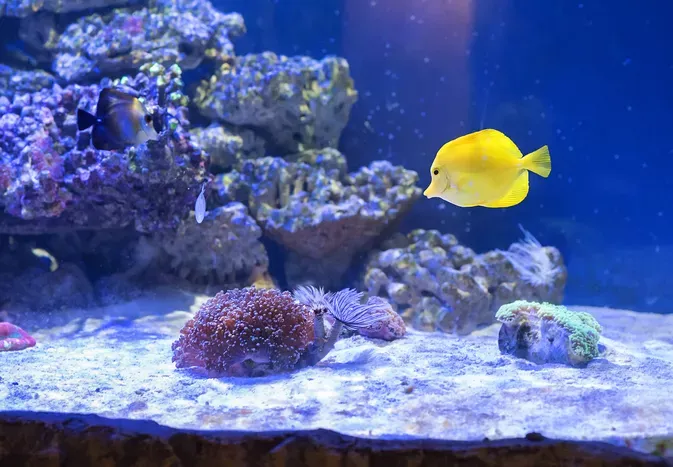Using Activated Carbon in Saltwater Aquarium Systems
Updated on 05/26/24

Unveiling the Power of Activated Carbon: A Comprehensive Guide for Saltwater Aquarium Enthusiasts
Maintaining a thriving saltwater aquarium ecosystem demands meticulous care and attention to detail. One crucial aspect of this delicate balance involves the effective removal of impurities and contaminants that can compromise the well-being of marine life. Activated carbon, a highly porous material with exceptional adsorption properties, has emerged as an indispensable tool for maintaining pristine water quality in saltwater aquariums.
In this comprehensive guide, we delve into the intricacies of using activated carbon in saltwater aquarium systems, exploring its benefits, optimal usage practices, and the scientific principles underlying its remarkable effectiveness.
The Magic of Activated Carbon: An In-Depth Explanation
Activated carbon is a specially treated form of carbon that possesses an incredibly large surface area, typically measured in hundreds of square meters per gram. This vast surface area, combined with a complex network of micropores, enables activated carbon to attract and hold a wide range of molecules through a process known as adsorption.
Unlike absorption, where molecules penetrate the interior of a material, adsorption involves the adherence of molecules to the surface of the adsorbent. In the case of activated carbon, the micropores provide numerous binding sites for molecules to attach, effectively removing them from the surrounding water.
Benefits of Using Activated Carbon in Saltwater Aquariums
The incorporation of activated carbon into saltwater aquarium systems offers a multitude of tangible benefits:
- Removal of Organic Pollutants: Activated carbon excels at adsorbing dissolved organic matter, including proteins, amino acids, and other waste products generated by marine organisms. By effectively removing these pollutants, activated carbon helps maintain water clarity and prevents the accumulation of harmful substances.
- Dechlorination: Chlorine, a common disinfectant used in tap water, can be toxic to marine life. Activated carbon can effectively remove chlorine from the water, ensuring the safety of aquarium inhabitants.
- Odor Control: Activated carbon also plays a crucial role in controlling unpleasant odors emanating from the aquarium. By adsorbing odorous compounds, activated carbon enhances the overall air quality around the aquarium.
- Improved Water Quality: The comprehensive removal of pollutants by activated carbon leads to improved water quality, creating a healthier environment for marine organisms.
Selecting the Right Activated Carbon for Your Aquarium
Choosing the appropriate activated carbon for your saltwater aquarium is paramount to maximizing its effectiveness. Consider the following factors when making your selection:
- Surface Area: Opt for activated carbon with a high surface area to ensure optimal adsorption capacity.
- Particle Size: Activated carbon is available in various particle sizes. Smaller particles offer a larger surface area but can clog filters more easily. Medium-sized particles strike a balance between surface area and filterability.
- Type: Coconut shell-based activated carbon is a popular choice for saltwater aquariums as it offers a high surface area and excellent adsorption properties.
Proper Usage of Activated Carbon in Saltwater Aquariums
To harness the full potential of activated carbon in your saltwater aquarium, follow these guidelines:
- Placement: Position activated carbon in a high-flow area of the aquarium, such as the sump or filter housing, to maximize water contact.
- Replacement Schedule: Activated carbon gradually loses its adsorption capacity over time. Replace the carbon regularly, typically every 2-4 weeks, to ensure optimal performance.
- Rinse Before Use: Rinse the activated carbon thoroughly before placing it in the aquarium to remove any loose particles that could clog filters.
Case Studies: Activated Carbon in Action
Numerous real-world examples showcase the effectiveness of activated carbon in saltwater aquariums:
- Odor Removal in a Coral Reef Tank: A heavily stocked coral reef tank experienced persistent unpleasant odors. The addition of activated carbon to the sump effectively eliminated the odors, creating a more enjoyable environment for both aquarium occupants and hobbyists.
- Removal of Dissolved Organic Matter in a Fish-Only Tank: In a fish-only tank with high fish density, water clarity suffered due to excess dissolved organic matter. Activated carbon supplementation significantly improved water clarity, resulting in a more aesthetically pleasing aquarium.
Conclusion
Incorporating activated carbon into your saltwater aquarium system is an essential step towards maintaining pristine water quality and a thriving ecosystem. By effectively removing impurities, dechlorinating water, controlling odors, and improving overall water quality, activated carbon plays a crucial role in safeguarding the health and well-being of marine organisms.
Understanding the principles and practices outlined in this comprehensive guide will empower you to harness the full potential of activated carbon in your saltwater aquarium, ensuring a vibrant and healthy marine environment for years to come.
Explore More Pets

Freshwater Aquarium Filters
How to Deal With Cloudy Aquarium Water

Saltwater Aquarium Filters
How Do You Remove Chloramines From Tap Water?

Freshwater Aquariums & Habitat
Can I Keep My Koi Fish Inside?

Saltwater Aquariums & Habitat
14 Best Floating Plants for Your Aquarium

Freshwater Fish Health
How to Treat Ich on Freshwater Fish

Saltwater Fish Health
Fin Rot in Aquarium Fish

Freshwater Aquarium Filters
How to Do Aquarium Water Changes

Saltwater Fish Health
How Do Fish Get Parasites?
